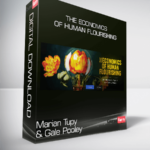🎈 Happy New Year 2025!
Use code HAPPY2025 to get 30% OFF on all products!
Limited-time offer. Don't miss out!
Peterson Academy – Marian Tupy & Gale Pooley – The Economics of Human Flourishing
Original price was: $499.99.$89.00Current price is: $89.00.
The course delves into the rise of environmentalism and its anti-humanism sentiments.
File Size: 5.582 GB.
Format File: 9 MP4, 9 SRT, 10 TXT.
- Description
- Reviews (0)
Description
Peterson Academy – Marian Tupy & Gale Pooley – The Economics of Human Flourishing


Dr. Marian Tupy
Researcher

Dr. Gale Pooley
Economist
In The Economics of Human Flourishing, an eight-hour course, Dr. Tupy and Dr. Pooley explore the new economics of resources and knowledge, challenging the notion that population growth inevitably leads to resource scarcity. The course delves into the rise of environmentalism and its anti-humanism sentiments. We examine the contrasting perspectives on population and resources, emphasizing the importance of shifting from a scarcity mindset to an abundance mindset by utilizing our shared human ability to seek out and develop new knowledge. We conclude by discussing the psychological and societal factors that threaten superabundance and the importance of fostering an environment conducive to innovation and progress.
Lectures
1. Ingenious Economics
In our first lecture, Dr. Marian Tupy introduces the new economics of knowledge, learning, and time, challenging the view that population growth inevitably leads to resource scarcity and poverty. He argues that human ingenuity and innovation enable the creation of new resources and the expansion of living standards, citing historical examples and outlining the devastating consequences of China’s one-child policy, which was rooted in Malthusian ideas.
2. Abundance Mindset
In lecture two we explore, with Dr. Gale Pooley, the contrasting perspectives on population growth and resource scarcity, focusing on the famous bet between Paul Ehrlich and Julian Simon. The lecture examines the relationship between population and resources, highlighting how the application of knowledge to atoms can create abundance, and concludes by emphasizing the importance of shifting from a scarcity mindset to an abundance mindset, recognizing the potential for human innovation to overcome resource limitations.
3. Price Perspective
In lecture three, Dr. Pooley explores the importance of looking at numbers and prices to understand economics and abundance. The lecture covers four key concepts: quantities, money prices, time prices, and changes in time prices over time. It emphasizes that while quantities are important, prices provide more valuable information about relative supply and demand. Furthermore, the lecture argues that time prices, calculated by dividing the money price by hourly income, are even more informative than money prices alone. By analyzing changes in time prices over time, we can gain insights into improving living standards and increasing abundance.
4. Personal Abundance
In lecture four, we apply the framework and equations discussed in the previous lecture to analyze abundance at the personal level. By calculating time prices for various goods and services across different time periods, we demonstrate how affordability has dramatically increased over time, despite rising nominal prices. Dr. Pooley emphasizes the importance of comparing oneself to the past rather than others in the present to gain a profound sense of gratitude for the abundance we enjoy today.
5. Resource Abundance
In lecture five, we explore applying our framework at the population level to analyze changes in resource abundance globally. We examine how population growth and personal resource abundance interact to determine overall resource availability. The lecture highlights the dramatic reduction in time inequality between countries like India, China, and the U.S. since 1960, discusses methods for indexing commodities and averaging percentage changes, and introduces the Simon Abundance Index.
6. Capitals of Innovation
In lecture six, Dr. Tupy introduces the Capitals of Innovation model, which examines how human beings create wealth and value for one another. The model begins with human beings, who live within a cultural context that influences their ability to innovate. Ideas, the product of human imagination, can become inventions when combined with various forms of capital, including physical, human, intellectual, and financial capital. Inventions become innovations when they are successfully tested in free markets by entrepreneurs and prove to be profitable. The lecture emphasizes the importance of cooperation, trust, and the continuous innovation of capitals in fostering economic growth and lifting people out of poverty.
7. Intellectual Revolution
In lecture seven, Dr. Tupy returns to explore the reasons behind the emergence of the age of sustained innovation in Western Europe around 200-250 years ago. He delves into the historical context, discussing the shift from extractive to inclusive political and economic institutions, the impact of geopolitical competition among European states, and the intellectual revolution that allowed reason to prevail over tradition. The lecture concludes by examining the change in attitudes towards innovation and commerce, which played a crucial role in fostering the modern era of sustained economic growth.
8. Eco-Anxiety
In lecture eight, Dr. Tupy discusses the rise of environmentalism in 19th-century Europe and its eventual importation into the United States, highlighting its anti-bourgeois and anti-capitalist sentiments that culminate in a condemnation of modernity and civilization. The lecture explores the growing strand of anti-humanism in the modern environmentalist movement, the rise of eco-anxiety, and the parallels between environmentalism and traditional religion in fulfilling the human need for meaning and transcendence in societies where traditional beliefs have receded.
9. Enduring Superabundance
In our ninth and final lecture, we explore the psychological and societal factors that threaten the continuation of superabundance, including negativity bias, population collapse, restrictions on free speech, and limits on market freedom. Dr. Tupy and Dr. Pooley finish by emphasizing the importance of recognizing these challenges and maintaining an environment conducive to innovation, collaboration, and the free exchange of ideas to ensure ongoing human progress and flourishing.
Get Digital Download ” Peterson Academy – Marian Tupy & Gale Pooley – The Economics of Human Flourishing ” Right Now!



Reviews
There are no reviews yet.